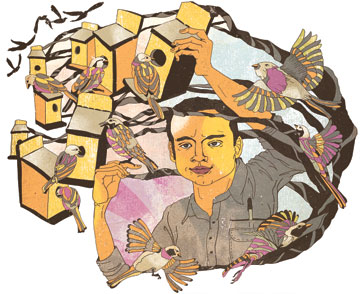
Among India's tiger-obsessed conservationists, Mohammed Dilawar is an oddity. The former lecturer in environmental studies once turned down an offer to work with tigers, dedicating himself instead to saving the sparrow. Using his own money and working from his home in Nasik in western India, Dilawar runs a project to preserve what he believes is one of India's most threatened birds.
The house sparrow was once so ubiquitous across India that it appears in folktales and songs. In 2005, when Dilawar stumbled upon a study of the declining population of house sparrows in Britain, he suspected that India was heading the same way, especially in fast-growing urban areas. As Dilawar realized, the fate of the diminutive bird was a portent of larger problems. "The sparrow is to urban ecosystems what the canary was to mines," he explains. "That it is dying out means our cities are in trouble." Dilawar scoured journals and libraries for studies to confirm his inkling, but found only one — a report by the Indian Council of Agricultural Research recording a dramatic drop in sparrow populations in southern India. So he determined to remedy what he calls a "criminal lack of scientific aptitude," starting out by conducting a nationwide survey of the sparrow population — an ambitious project that will take years to complete.
In the meantime, Dilawar is doing what he can to protect the tiny birds. There is, it seems, a lethal combination of reasons for the sparrow's decline. Modern architecture and shrinking gardens and parklands have rendered sparrows homeless, since they like to nest in nooks and crannies. Meanwhile, use of pesticides has killed off the bugs the bird needs to feed its young.
Dilawar has taken the bird's plight to heart. "One day, I saw a sparrow building a nest in the switch box of a telephone pole," he says. "I decided then and there to give a little help to this hardy little creature." And so it was that he began to design wooden nesting boxes. After experimenting at home, he started manufacturing and selling them on a nonprofit basis. In less than three years he's sold more than 1,000 of these "nests" and bird feeders. "It's heartening," he says, "to hear back from families that their children are thrilled to watch chicks hopping about, being fed by the mother."
Dilawar concedes that this is just a tiny step. "We need to involve the government and the scientific community," he says. "We must plant hedges and trees ... must stop using chemical pesticides near our homes." But securing funding for such a plain, unexotic creature isn't easy. "In India, we only think of the glamorous tiger," he says. "But if we don't act now to save the house sparrow, our children may only hear of sparrows in stories and never get to see one."